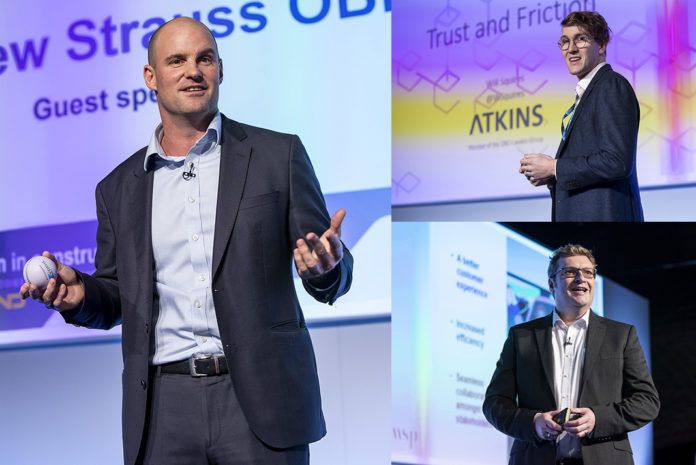
On Friday, November 16 BSRIA welcomed almost 400 industry professionals to The Brewery in London for its annual briefing. This flagship event was opened by BSRIA chief executive, Julia Evans.
Julia set the scene: disruption in construction – driving technologies and processes for the future could be seen as “the curse of living in interesting times”. But BSRIA was here to provide certainty.
With that, Julia welcomed the speakers and the chair, Oliver Zimmerman, CEO, Condair Group AG, asked what does it mean to be disrupted? As an industry, we should be “fascinated and excited” and our competitors should be “anxious and scared”!

The keynote speaker, Susan Hone-Brookes, chief engineer for construction, infrastructure and energy at the Manufacturing Technology Centre (MTC), sited current changes within the framework of the 4th industrial revolution.
Susan said that while both Google and the Egan report appeared in 1998, it’s Google that has had a lasting legacy on the industry. She emphasised poor productivity in the construction industry and forecast a period of consolidation as companies struggle with low margins.
She named some good news stories, such as the i3P model for industry collaboration, the development of the vertical factory for constructing high-rise buildings and new technologies such as drones. She suggested it is difficult to predict what will come next, but we are likely to need creativity rather than encyclopedic knowledge and it is clear we will have to adapt to survive. We must also learn from the past.
Co-existing with robotics and, indeed, go-bots could be the answer for self-assembly and to “solve the problem before it arises”.

Mike Potter, managing director and founder of DriveElectric, looked at: Electric vehicle disruption? Saying it is ever more evident that electric vehicles (EVs) are the future. Especially with the law of conservation in energy.
He explained that electric motors are more efficient than petrol or diesel engines, have lower maintenance costs, batteries are getting cheaper and the range is getting better.
However, there was a question mark over whether they were cheaper to buy and easy to use – with 95% of charging points at home or work. But battery charging, followed by battery range, is the main reason that stops EVs working.
By 2027, half of all new car registrations will be EVs, registering around 1.3 million a year. This could add 50% to peak demand for electricity in households. The timing of this demand does not work well against the availability of renewable energy, especially when there is an inclination for all vehicles to be plugged in early in the evening, charging at the same time.
He suggested this was superfluous as most vehicles wouldn’t actually be used until the morning, so demand management is achievable to spread the load. Flexibility at its best. Cheap, renewable generation, energy storage in the grid, wind power, and a Crowd Charge algorithm can help – leading to a reduction in costs for EVs.
Mike said that it was natural for users to ask: “will my (EV) car work?” and “will I have to squash the power in?!”.
Philip Guthrie, collaboration hub project officer for London Waste & Recycling Board (LWARB), considered: Circular economy in London: driving from policy to practice, design to demonstration.
“… a circular economy keeps products and materials circulating within the economy at their highest value for as long as possible, through re-use, recycling, remanufacturing, delivering products as services and sharing.”
Philip said that “London is growing fast” with the population predicted to reach 11 million by 2050, which means our attitude to waste needs to change. The circular economy provides a sustainable and profitable solution to the challenges of this dramatic growth. By 2041 we could reduce waste by 60%. By 2036, the circular economy could provide London with net benefits of at least £7 billion every year and 40,000 new jobs (12,000 net additional jobs) in the capital by 2030. London’s Circular Economy Route Map outlines practical actions to transition London to a circular economy while providing jobs, growth and impact.
The economics behind it and the business model was key. When working smarter: more money can be made. This fitted in with the Mayor’s Procurement Policy and could, indeed, be rolled out across the UK.
Adrian Malone, head of digital project delivery & BIM, Transport & Infrastructure at WSP, gave a vision for digital transport infrastructure. He explained that WSP was trying to drive up productivity and efficiency in the sector: “we can do more with less” and concentrating on the use of digital technologies to deliver this.
An increase in efficiency – means thinking differently, being open to and embracing change and seamless collaboration among stakeholders: good collaboration drives efficiency and better customer outcomes.
Adrian explained that digital isn’t only about technology. It’s really about people, process and business models.
William Gibson, novelist who coined the term cyberspace, said: “the future is already here – it’s just not very evenly distributed”.
This means that if you want an idea of what the future will look like, look at the pockets of innovation which have not yet become widely adopted and imagine a future where those things have become common.
On the horizon, Adrian said, is the digital twin: a digital replica of an asset: such as a section of motorway. It is a connected, real-time replica of the actual asset it represents thus creating a high level of data – both static and dynamic – that can be used in combination with technologies such as A.I. to improve performance and even to predict problems.
Adrian advocated that the future would be one of “human-aided design”, driven by automatic software and allowing engineers to focus on “customer outcomes rather than design problems”.
Will Squires, digital lead for cities and development and aviation in SNC-Lavalin’s Atkins business, unraveled some of the enigma of blockchain and bitcoin and how “trust and friction” are key themes. Will explained that blockchain could increase security, change behaviours, lower the cost of projects in construction and speed up such payments.
Indeed: with the high transaction costs within the complex interactions of the construction industry, blockchain could be seen as a “trust machine”.
When money is “passed down the system” it should only be “touched once”: organisational costs were immense – even with a scattered distribution. Industry could ask: “what have we done and what haven’t we done?”.
It could be used to allow distributed project information, rather than the centralised ‘common data environment’ generally adopted today.
With $94 trillion of infrastructure spending required to deliver quality of life to the entire global population by 2040, the possibility for savings is enormous. Blockchain can allow us to achieve this without introducing a new point of failure.
There were currently “complex problems” and cost and schedule overruns in the construction sector. Will cited some major projects that had gone “catastrophically” over-budget which included: the International Space Station; the London Olympics; and HS2 Phase 1 – Birmingham to London.
The afternoon keynote speaker was cricketing-legend Andrew Strauss OBE who shared his experience on nurturing high-performing teams. Andrew captained the England Cricket Team and lead them to win back-to-back Ashes – both home and away.
Andrew talked about what is required to achieve a high level of performance – there isn’t a “magic bullet” – and some of the reasons it does not always go according to plan. He said it is necessary to be able to think for yourself, that you should not treat your organisation like a lease car – where you can just hand it back at the end of day – and that you have to get rid of distractions.



